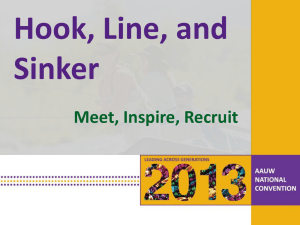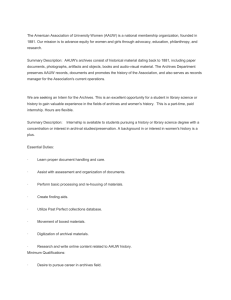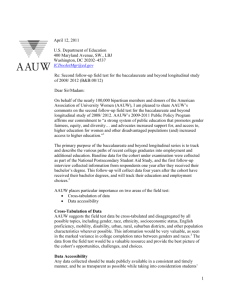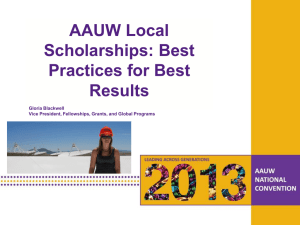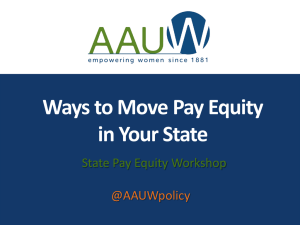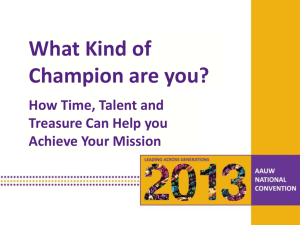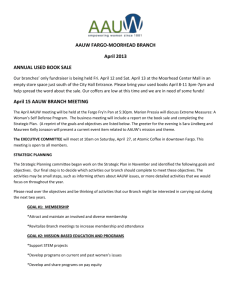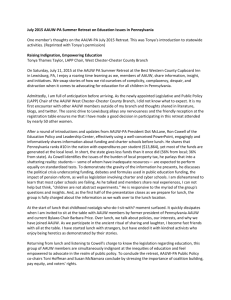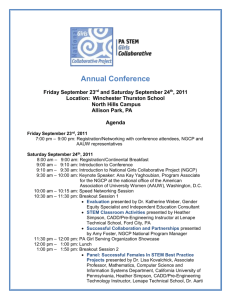AAUW 2015 National Issues_For State Leaders_5.8.2015
advertisement
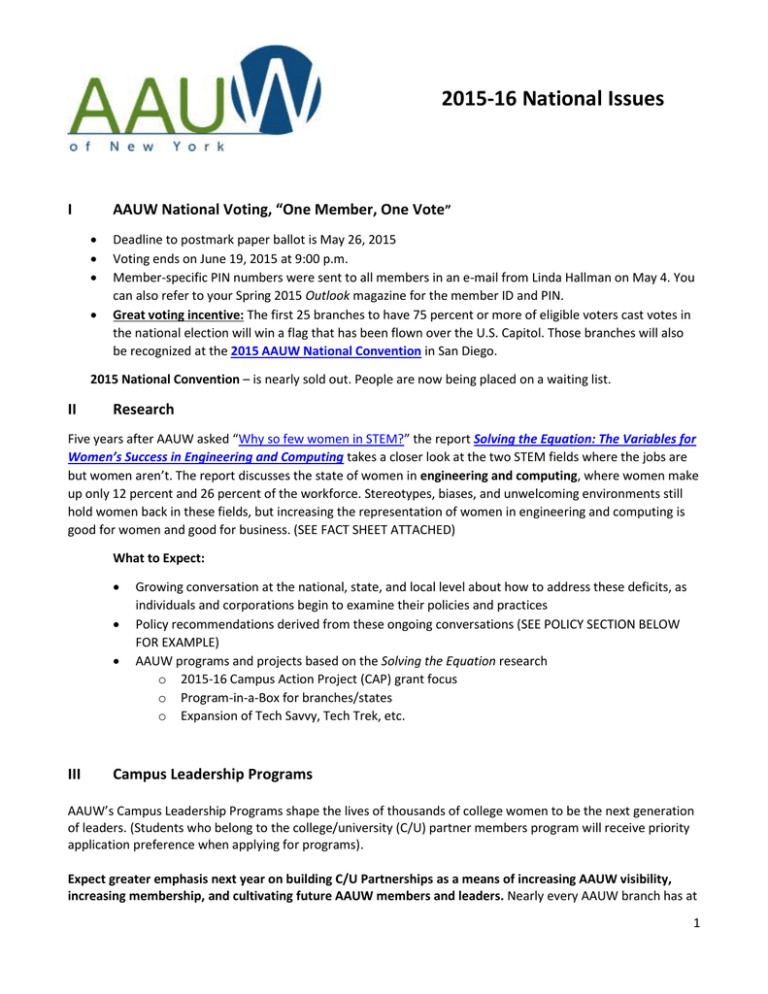
2015-16 National Issues I AAUW National Voting, “One Member, One Vote” Deadline to postmark paper ballot is May 26, 2015 Voting ends on June 19, 2015 at 9:00 p.m. Member-specific PIN numbers were sent to all members in an e-mail from Linda Hallman on May 4. You can also refer to your Spring 2015 Outlook magazine for the member ID and PIN. Great voting incentive: The first 25 branches to have 75 percent or more of eligible voters cast votes in the national election will win a flag that has been flown over the U.S. Capitol. Those branches will also be recognized at the 2015 AAUW National Convention in San Diego. 2015 National Convention – is nearly sold out. People are now being placed on a waiting list. II Research Five years after AAUW asked “Why so few women in STEM?” the report Solving the Equation: The Variables for Women’s Success in Engineering and Computing takes a closer look at the two STEM fields where the jobs are but women aren’t. The report discusses the state of women in engineering and computing, where women make up only 12 percent and 26 percent of the workforce. Stereotypes, biases, and unwelcoming environments still hold women back in these fields, but increasing the representation of women in engineering and computing is good for women and good for business. (SEE FACT SHEET ATTACHED) What to Expect: III Growing conversation at the national, state, and local level about how to address these deficits, as individuals and corporations begin to examine their policies and practices Policy recommendations derived from these ongoing conversations (SEE POLICY SECTION BELOW FOR EXAMPLE) AAUW programs and projects based on the Solving the Equation research o 2015-16 Campus Action Project (CAP) grant focus o Program-in-a-Box for branches/states o Expansion of Tech Savvy, Tech Trek, etc. Campus Leadership Programs AAUW’s Campus Leadership Programs shape the lives of thousands of college women to be the next generation of leaders. (Students who belong to the college/university (C/U) partner members program will receive priority application preference when applying for programs). Expect greater emphasis next year on building C/U Partnerships as a means of increasing AAUW visibility, increasing membership, and cultivating future AAUW members and leaders. Nearly every AAUW branch has at 1 2015-16 National Issues least one C/U nearby. All of the resources/initiatives mentioned in this document should be used to engage C/U partners, with an emphasis to faculty and staff that many AAUW policies/advocacy/initiatives benefit them as well as the students. A. Give a Grad a Gift - AAUW members can give recent college graduates a free, one-year AAUW national membership within two years of graduation, at no cost to you or them. This is a great recruitment tool. It does not matter where the grad lives or where they may be moving to. Find out where they’re headed after graduation and give them the name of the closest AAUW branch and a point of contact. B. Start an AAUW Student Organization - AAUW student organizations give students the resources and support to engage in their community on gender equity issues. Members gain leadership skills, create change on campus, address discrimination, and connect with a national community. And AAUW members can play a huge role in engaging AAUW Student Orgs on college campuses. Current AAUW Student Orgs in NY: Fulton-Montgomery CC, Jefferson CC, University at Buffalo, Westchester CC (Daemen College and several others have applied to be formally recognized) C. National Conference for College Women Student Leaders (NCCWSL) – May 28-30, 2015. Registration is now closed. Invite NCCWSL attendees and scholarship recipients to share their experience at an upcoming branch meeting/event. Ask them to help the local AAUW branch table on campus in the fall during orientation. D. Elect Her–Campus Women Win is the only program in the country that encourages and trains college women to run for student government and future political office. A collaboration between AAUW and Running Start, Elect Her addresses the need to expand the pipeline to women running for office and to diminish the longstanding political leadership gender gap. More than 50 Elect Her sites nationwide. 5 in NY (Ithaca College, Stonybrook, SUNY Albany, Syracuse University, University at Buffalo) Sign up Elect Her participants for the Action Network so they can continue to be AAUW activists and stay engaged E. $tart $mart Salary Negotiation Workshop – College women entering the job market need the confidence, knowledge, and skills required to negotiate their salaries and benefits. $tart $mart teaches them to do just that. More than 225 campuses across the country have hosted. Coming soon – Work $mart – for women changing careers or looking to get to the next level. Become a trained facilitator to help your branch engage local C/U partners and reduce the cost of the workshops. 2 2015-16 National Issues IV Programs Mission-based programs will grow your AAUW community. This is where branches need to focus a lot of time and energy this year. Assess the interests of your branch members and the community, and link your programs to the topic(s) most relevant to both. Get started by conducting a survey of your members. You can list topics beforehand and then have your members rank them in importance. You’ll find a substantive list of potential community outreach just in the following areas alone. Programs that focus on AAUW public policy issues: civil rights, social injustice, hate crimes prevention, reproductive rights, economic security, work-life balance, access to child care, pay equity, retirement security, health care, career and technical education, higher education and student loan debt, Elementary and Secondary Education (ESEA) and k-12 education, common core, universal pre-K, STEM education, Title IX, campus sexual assault or sexual harassment. Programs that use AAUW research reports on issues like women in community colleges, the pay gap for women one year out of college, campus sexual assault, and the underrepresentation of women and girls in STEM. V Membership & Leadership Membership recruitment and retention should focus on the development of mission-based programming and leadership development. Emphasize quality over quantity. A. Shape the Future - The Shape the Future membership campaign is a great recruitment tool for current members to offer a discounted rate to prospective members. New members and students can take 50 percent off the national dues rate when they join on the spot during an AAUW public event. Branches also earn one free national membership to give away for every two newly recruited members, with a maximum of five free memberships annually. B. Younger Women’s Task Force (YWTF) – now in NYC and CNY. YWTF is a movement by and for younger women to fight for social justice. Together we form a diverse and inclusive group of activists, organizers, allies, and professionals that is both local and nationwide. But we’re also a community founded on the belief that we can work within and beyond the women’s movement to change the things we care about. AAUW acquired YWTF in 2013 as an affiliate. Which means, that if you are a YWTF member, you are an AAUW member as well. AAUW views this relationship as a way to retain the interest and engagement of young women recently out of college and starting their careers, and providing them with an activist lens through which to advocate for AAUW’s issues. As dual YWTF and AAUW members, these empowered women will help us bridge the age gap in our current membership and be ready to lead AAUW as our next generation of leaders. 3 2015-16 National Issues Our focus: Leaders who look and think like us; Access to health care for women; Fair pay for women; Work-life balance; Equal access to education; Reproductive rights; An end to human trafficking; An end to violence against women. C. Leader Essentials – is a collection of resources for AAUW Officers. As an AAUW leader, you want to stay on top of best practices and hone your own personal leadership skills. These Leader Essentials, formerly the Starter Kit, include almost everything you need to know to be effective and achieve success in your leadership role. Use these resources to map out recruitment and retention strategies for the year; raise awareness of AAUW’s mission with mission-based programs; develop branch leaders, etc. D. Member Services Database (MSD) – every AAUW member has access to the MSD from the AAUW homepage using their member ID. Branch and state leaders can maintain branch membership records on the MSD and access the national membership list for recruitment efforts! (CHART SHOWS WHO HAS ACCESS/RIGHTS TO MEMBER DATA) We need to start using the MSD more effectively to maintain our records and know our membership. E. Membership Payment Program (MPP) – online dues processing system for the state and branches. It is free to use. The only requirement for use is that a branch has a bank account. This process eliminates a lot of the labor the branch Treasurers and Membership Chairs go through every year in tracking down dues. Individual members can pay online. That payment goes directly to national, and the state and branch portion of the dues payment is deposited directly into those accounts. The Treasurer and Membership Chair can access the MSD to view a list of receipts of payment and which members have not renewed yet. Benefits: Fast and efficient – research shows that states/branches who use the MPP retain more members and attract new members who prefer to pay online. Eliminates paperwork and stacks of checks. For those who still prefer to pay their dues by check, they are not prohibited from doing so. VI Development AAUW will be placing a greater emphasis on giving to the AAUW Fund in the coming year, to maximize the use and appropriations of member contributions. Currently, only one program - fellowships and grants – is fully funded by gifts designated to this specific area. Every other AAUW program relies on undesignated or unrestricted gifts to operate and expand. For this reason, members are encouraged to consider designating your future contributions to the AAUW Fund, also known as the general fund. Every other program receives full or partial funding from the AAUW Fund, which derives primarily from unrestricted contributions, with a small amount coming from dues and sponsorships. The AAUW Fund allows AAUW to react to new challenges; develop, disseminate, and sustain programs; and pay for all the 4 2015-16 National Issues programs members have come to love, such as $tart $mart, local and national advocacy efforts, Tech Trek, Elect Her, Tech Savvy, and many more. Many members are under the impression that membership dues cover these expenses. However, just 30% of AAUW’s expenses are actually covered by membership dues. In the past, dues covered program support, but this hasn’t been true for quite some time. Costs rise yearly, while dues have remained the same. More of our members are also not affiliated with branches, so the costs of member acquisition and retention have risen. Most important, AAUW programs like Tech Trek, Tech Savvy, and $tart $mart have become increasingly popular with members across the country. But as new program development and local implementation have grown, the revenue from membership dues has not kept pace. Thus, contributions to the AAUW Fund are critical to sustaining program growth and responding to increasing member demand for high-quality mission-based programs. VII Policy It is important to note that the 2015-17 Public Policy Program will be voted on at the National Convention and officially published shortly thereafter. A. Reauthorization of the Elementary & Secondary Education Act (ESEA) – Congress has failed to reauthorize this bill since 2007, which means that it has not been changed/updated since the last reauthorization in 2002, when it was renamed No Child Left Behind (NCLB). We need to make sure that Congress is committed to ensuring strong academic principles and to closing the achievement gap for all children — objectives at the heart of ESEA. We also must insist on adequate funding for education priorities. The federal government has a critical role to play in attaining these goals, and AAUW endorses the use of a robust accountability system that helps ensure all children are prepared to be successful, participating members of our democracy. More specifically, AAUW wants the reauthorized education bill to: Spends public funds on public education only — not private school vouchers or "portability" schemes that would pave the way for vouchers in the future; Holds schools accountable for demonstrating that they are meeting educational goals; Requires annual, statewide assessments that measure each student's progress toward meeting the state's college and career-ready standards; Requires schools to collect and break-down data on students' performance by subgroups so they can identify and close achievement gaps; and Reauthorizes and fully funds the Women's Educational Equity Act to provide resources to fully implement Title IX. Two-Minute Activist: http://salsa4.salsalabs.com/o/50796/p/dia/action3/common/public/?action_KEY=12289&killorg=True B. New Toolkit for Title IX Coordinators: 5 2015-16 National Issues Title IX requires that every school must designate at least one employee who is responsible for coordinating the school’s compliance. This person is sometimes referred to as the Title IX coordinator. Coordinators oversee all complaints of sex discrimination. They also identify and address any patterns or systemic problems at their schools. Instead of giving these coordinators the support, guidance, and training they need to do their work, we’ve seen time and time again that many schools are without a Title IX coordinator. It is also unfortunately quite common to find coordinators who do not understand the scope of the law. To remedy this problem, the U.S. Department of Education’s Office for Civil Rights has just released three sorely needed tools that AAUW asked for: a letter to schools reiterating the importance of Title IX coordinators, a thank-you letter directly to coordinators reaffirming their roles, and a free resource manual to guide their actions. The information is not a new requirement or regulation but rather a new resource to help Title IX coordinators do their work better. These tools are a big deal because they stress that 1. Title IX coordinators need authority and are independent. Title IX complaints are up, and so is the stress on Title IX coordinators to be independent. From 2009 to 2012, the Office for Civil Rights received nearly 3,000 Title IX-related complaints, more than ever before in a similar period. This guidance gives Title IX coordinators leverage to use in their communities to implement important notices, grievance procedures, and accountability measures that are required under the law. Persons not suited for this type of role, such as athletics directors or administrators with clear conflicts of interest, will have clear direction as well that this may not be the role for them. 2. Title IX coordinators need resources. Public awareness of the broad scope of Title IX issues is finally receiving attention. The law applies to recruitment and admissions; counseling; financial aid; sexual harassment, including sexual violence; pregnant and parenting students; school discipline; single-sex education; and employment. It also ensures that there are reporting options, grievance procedures, and nonretaliation Title IX coordinators will now have a resource guide to assist educating their communities about all of Title IX’s scope. 3. Title IX coordinators should be recognized and thanked for their invaluable work. For the first time in 43 years, Title IX coordinators will get an official recognition of the critical work they are doing to uphold civil rights laws. And, as a bonus, they finally get a detailed job description. Imagine having to read a federal regulation and case law to figure out what your job requires! Now they will have a free and easyto-read resource guide to pave the way. AAUW celebrates the long overdue attention being paid to Title IX coordinators. We will be encouraging all of our members to contact local schools — both P-12 and higher education — to make sure they have a Title IX coordinator and that the coordinator has a copy of these new resources. C. STEM Opportunities Act of 2015 (H.R.467) 6 2015-16 National Issues Reducing barriers that deter women and underrepresented minorities from pursuing academic and career goals in STEM fields isn’t just simply the right thing to do; it’s the smart thing to do. In these fields, where the number of jobs often outnumber qualified applicants, expanding the talent pool to include more women and minorities would boost job numbers, economic security and our competitiveness in the global economy. Congress is currently considering the STEM Opportunities Act of 2015 (H.R.467), which includes substantive efforts to broaden participation in STEM to include women and underrepresented minorities. Other STEM bills, including the America COMPETES Act, which will soon be up for debate on the House floor, do not make any effort to broaden STEM participation. In fact, it drastically cuts the National Graduate Research Fellowship Program which is the kind of program that can help prepare women for careers in the STEM field. The Bureau of Labor and Statistics estimates that by 2020, more than 9.2 million jobs will be in science, technology, engineering, and mathematics (STEM) fields. Moving women and underrepresented minorities into science, technology, engineering, and mathematics is not only important for global competitiveness but is also critical to maintain the strength of the U.S. labor force and economy. D. Continued work on Gender Wage Gap, Work-Life Balance, and Economic Justice Paycheck Fairness Act Increasing the Minimum Wage Paid Family Leave and Paid Sick Days Health Care and Reproductive Health Decreasing Student Loan Debt 7

